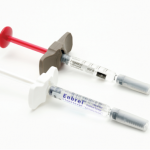In the real-life, open-label trial, researchers randomized 79 patients who had had certolizumab pegol added to their treatment after having an inadequate response to nbDMARDs, including methotrexate (MTX) and other drugs. On the combination, the patients had had at least a 1.2-point improvement on the DAS28-ESR scale.
At either three or six months, patients were randomized to stay on the combination or to have the nbDMARD removed, and then they were followed for 18 months. Patients had the option to stay on their nbDMARD, even if they met the criteria for having it withdrawn. Thirty-five patients were in the combination group and 44 in the monotherapy group. There were no significant differences between the groups in age, gender, rheumatoid factor status or experience with prior biologics.
After 18 months, with adjustments made for baseline scores, similar improvements were seen for the groups on DAS28-ESR, with an improvement of 2.1 points in the combination group and 2.0 points for the monotherapy group, said Janet Pope, MD, MPH, chair of rheumatology at St. Joseph’s Health Care in London, Ontario, who cautioned these were interim data only and that the results should be interpreted cautiously.
Researchers also found that the odds of achieving a DAS28 low disease activity status, or an improvement of at least 1.2 points on the DAS28, or both were no different between the two groups.
“What if someone’s getting a response on certolizumab pegol in usual care with active RA, what if we withdraw their active DMARD—or not?” Dr. Pope said. “The results look very similar whether [or not] you continue background DMARDs. We will find the real results, the full data set, very soon.”
Adding Glucocorticoids
In another study, researchers found that adding glucocorticoids to intensive treatment with biologics and MTX for early, aggressive RA did not produce better results and led to a higher percentage of patients who stopped their therapy because of adverse events, said Roberto Caporali, MD, professor of rheumatology at the University of Pavia in Italy.3
The trial included glucocorticoid- and MTX-naive patients with active RA for at least a year and a least one predictor of aggressive disease. All patients received adalimumab for 12 months and MTX through two years. They were randomized to get either placebo or prednisone, at 50 mg a day tapered to 6.25 mg a day.
At one year, remission—DAS28 of less than 2.6, SDAI of no higher than 3.3 and CDAI of no more than 2.8—was seen in 56.3% in the placebo group and 45.3% in the glucocorticoid group (P=.07). Researchers also found that DAS28 remission at two years was seen in 36.8% of the standard therapy group and 30.9% of the glucocorticoid group.

